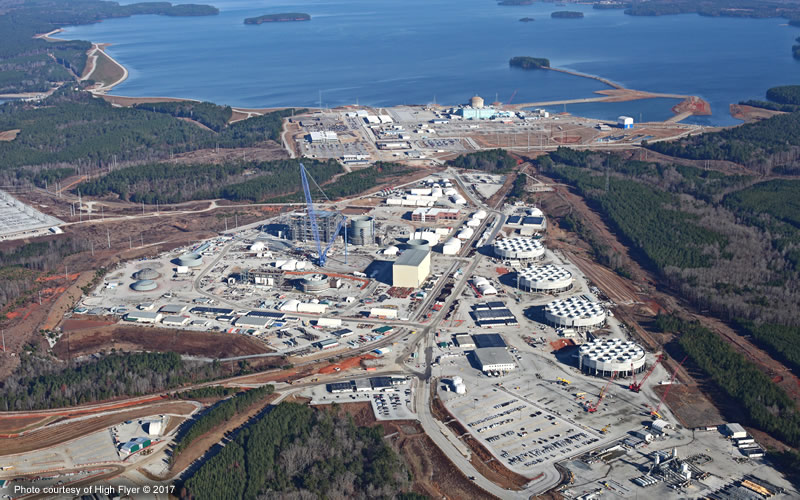
An overhead view of the V.C. Summer plant; (e.g. Photo courtesy of High Flyer © 2017)By Eddy Moore, special to Statehouse Report | When South Carolina utilities abandoned two nuclear plants after spending $9 billion, S.C. House Speaker Jay Lucas urged lawmakers to “find the flaws that led to this systemic failure.”
House and Senate investigative committees diligently exposed feckless utility management and the folly of the Base Load Review Act, which insulated utility companies from financial risk and left ratepayers “holding the bag” for the project.
The investigations showed the legislature at its best and has produced proposed legislation that is a step forward. But these investigations still did not fully expose the root of the failure, which goes beyond the Base Load Review Act, the absence of an official public utility consumer advocate in South Carolina, or the makeup of the Public Service Commission.
These deficiencies stem, directly or indirectly, from a system of regulation that assigns profit to utilities based on the size of capital investments, rather than on most efficiently meeting the state’s energy needs.
This system was designed to solve a problem from 100 years ago: attracting the financial capital needed to build out an electric system, including power plants and power lines, to vast regions of the country that did not have the money to pay for it. Across the nation, state regulators made utility profits dependent on the amount of utility capital invested in useful structures within the utility territory—not on non-capital costs such as salaries, maintenance or fuel, all of which are passed through to customers without profit.
A bias towards capital investment remains: When faced with customer needs today, regulated utility companies still tend to favor solutions that require a large expenditure of capital rather than the increasingly diverse array of alternative services that also meet customer needs, often at lower cost. A decade ago, South Carolina regulated utilities could have chosen several pathways forward to meet projected customer needs. But the mother of all capital investments (and thus the mother of all profits) is a nuclear plant, which predictably became the solution they brought to the legislature, with enabling legislation: the Base Load Review Act.
Many utility regulators throughout the nation recognize this capital bias and are developing innovative responses so that utilities will continue to best serve customers as times change. South Carolina legislators should join this conversation, exploring regulatory models for what those in the industry call the “utility of the future.” More immediately, legislators should nurture the seeds of reform that have already been planted here in South Carolina:
First, our regulations already allow utilities to earn profit from saving energy on a performance basis. But our utilities still have a larger competing incentive to spend capital and sell more energy to recoup those investments, and we do not set a high bar for energy savings. This leaves hundreds of millions of dollars in savings on the table. We should require energy savings when it is the least-cost option, set ambitious energy savings targets to ensure cost savings and reduce a utility’s dependence on increased sales for profits. This is just one example of a trend towards “performance-based ratemaking” and away from rewards based purely on the amount of money sunk.
Second, our regulations require utilities to submit their plans for review. But they do not require a thorough comparison of capital-intensive solutions, such as power plants, with alternatives that require little or no utility capital investment, such as enabling groups of large energy users to reduce demand when grid costs are high or recognizing the value of customer-owned power production. Legislators in South Carolina need to ensure that all options are on the table—not just the ones in which utilities risk capital on behalf of ratepayers—and that plans are transparent and open to meaningful public participation and review.
Third, it is no longer necessary for the utility to be the only investor in energy production. South Carolina has made a strong start in the solar market—with the help and good work of our utility companies—but artificial legal barriers hamper market-based solar expansion. Burgeoning solar options, battery storage and a host of information-based technologies offer new ways for project developers and customers to participate in the energy economy. Legislators should embrace this trend, establishing clear customer rights to manage their own energy needs within a framework that rewards utilities for enabling the use of these technologies.
We will not make the most of the lessons learned from nuclear plant abandonment until we address its root cause. Much more is at stake than $9 billion: South Carolina electric utilities will likely take in over $70 billion during the next decade and over $100 billion during their current 15-year planning horizon. Regulatory decisions now will determine how that money is invested. Surely, we can find a more fitting and smart underlying motivator to allocate these funds for the benefit of all South Carolinians than maximizing utility capital investment.
Eddy Moore, a South Carolina native who served as an administrative law judge in Arkansas, is energy and climate program director with the S.C. Coastal Conservation League.















 We Can Do Better, South Carolina!
We Can Do Better, South Carolina!